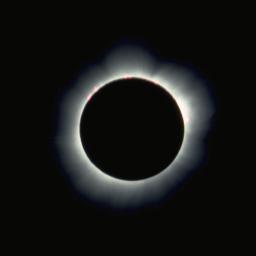Eclipse
|
|
- This article discusses astronomical eclipses. For other meanings, see Eclipse (disambiguation).
An eclipse (Greek verb: ecleipo = 'cease to exist') is an astronomical event that occurs when one celestial object moves into the shadow of another. The term is most often used to describe either a solar eclipse, when the moon's shadow crosses the earth's surface, or a lunar eclipse, when the moon moves into the shadow of the earth. However, the term eclipse is also used to describe the phenomenon in which one of Jupiter's moons passes into the shadow of Jupiter, or when one of Jupiter's moons passes into the shadow cast by one of its other moons.
An eclipse is a type of syzygy, as are transits and occultations.
The most dramatic eclipses from Earth are:
- Lunar eclipses - the Earth obscures the Sun, from the Moon's point of view. The Moon moves through the shadow cast by the Earth. This can only happen at full moon.
- Solar eclipses - the Moon occults the Sun, from the Earth's point of view. The Moon casts a shadow that touches the surface of the Earth. This can only happen at new moon.
Total eclipses occur where the light source is totally blocked off by the eclipsing body. For total solar eclipses, the viewer is in the umbra part of the Moon's shadow.
Eclipse99mir.jpg
Partial eclipses occur at places where only part of the luminary is covered (solar eclipses), or when only part of a body is eclipsed by the shadow (lunar eclipses). For solar eclipses, the viewer is in the penumbra part of the Moon's shadow.
An annular eclipse is a total eclipse of luminary where a thin ring of light is visible around the intervening object. For solar eclipses, the viewer is in the antumbra part of the Moon's shadow. It is sheer coincidence that the Moon and Sun have nearly equal apparent sizes, making annular eclipses possible. Annular eclipses are ideal times for observing solar prominences.
There is also another type of solar eclipse; the Hybrid solar eclipse. It consists of three phases. The eclipse starts as an annular one, then turns into a total and by the end it returns to the annular phase.
An eclipse involving the Sun, Earth and Moon can only occur when they are in a line. Because the plane of the orbit of the Moon is tilted with respect to the plane of the orbit of the Earth (the ecliptic), eclipses occur only when the three bodies are near the intersection (the node) of these planes. The Sun passes either node once a year, and eclipses occur in a period of about two draconic months around these times. There can be from two to seven eclipses in a calendar year. They repeat according to eclipse cycles.
| Contents |
Eclipse phases
General phases of a solar eclipse
- The general eclipse begins when the Moon's penumbra cone starts to sweep across the Earth's disc.
- The total or annular eclipse begins when the Moon's umbra starts to sweep across the Earth's disc.
- The centrality begins when the axis of the Moon's shadow cone starts to sweep across the Earth's disc.
- The eclipse's maximum occurs when the terrestrial surface within the umbra reaches its largest area.
- The centrality ends when the axis of the Moon's shadow finishes its sweep across the Earth's disc.
- The total or annular eclipse ends when the Moon's shadow finishes its sweep across the Earth's disc.
- The general eclipse ends when the Moon's penumbra finishes its sweep across the Earth's disc.
Local phases of a solar eclipse
- First contact (also called first exterior contact) is the instant when the Moon's disc starts to cover the Sun's.
- Second contact (also called first interior contact) is the instant when the Moon's disc is entirely surrounded by the Sun's (for an annular eclipse) or the instant when the Sun's disc disappears completely behind the Moon's (for a total eclipse).
- Third contact (also called second interior contact) is the instant when the Moon's disc starts to come out of the Sun's (for an annular eclipse) or the instant when the Sun's disc reappears from behind the Moon's (for a total eclipse).
- Lastly, fourth contact (also called second exterior contact) is the instant when the Moon's disc clears the Sun's.
Phases of a lunar eclipse
There are three types of lunar eclipses: penumbral, when the Moon crosses only the Earth's penumbra; partial, when the Moon crosses partially into the Earth's umbra; and total, when the Moon crosses entirely within the Earth's umbra.
- First contact (also called first exterior contact) is the instant when the Moon starts to enter into the Earth's umbra.
- Second contact (also called first interior contact) is the instant when the Moon enters completely into the Earth's umbra. This is the beginning of totality.
- The maximum of the eclipse occurs when the angular distance between the centre of the Moon's disc and the centre of the shadow cone is at its smallest value.
- Third contact (also called second interior contact) is the instant when the Moon starts to come out of the Earth's umbra. This is the end of totality.
- Lastly, fourth contact (also called second exterior contact) is the instant when the Moon clears the Earth's umbra completely.
The eclipse in mythology
Before modern astronomy there were explanations for eclipses in every culture of long standing. These would typically involve conflicts between mythic forces. At the Imperial observatory, Beijing is a carved stone brought from a distant province with the following explanation (here rewritten):
- "This carved stone chart explained the cause of solar eclipses. The center of the golden bird (the symbol of the sun) was covered by the toad (the symbol of the moon). The people of the Han Dynasty called the phenomenon a good combination of the sun and the moon."
In this explanation we see a recognition of the celestial realities and a cheerful outlook regarding the event. In other cultures an eclipse could be both a surprising and a terrifying event.
The eclipse in astrology
In the field of astrology an eclipse is seen to clip something out. What precisely is clipped out is reflected by the sign and house that the eclipse occurs in.
See also
- Eclipse cycle
- Eclipsing binary
- Pharaoh (historical novel by Bolesław Prus, incorporating a solar-eclipse scene likely inspired by Christopher Columbus' use of a lunar-eclipse prediction).
External links
The following web page lists many of the cycles over which solar and lunar eclipses repeat, including the Saros and Inex:
Search 5,000 years of eclipse data by Saros number or simply by year on the following site:
Dr. Fred Espenak's eclipse site:
el:Έκλειψη es:Eclipse fr:Éclipse id:Gerhana matahari ms:Gerhana matahari nl:Eclips pl:Zaćmienie pt:Eclipse th:อุปราคา


